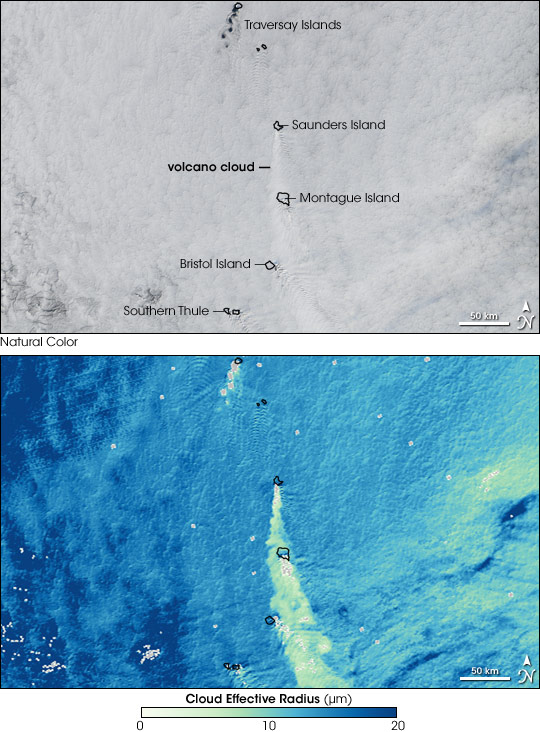


It is not difficult to imagine that a gigantic volcanic eruption spewing thick clouds of ash and gas high into the atmosphere would change the weather. After the Philippines’ Mount Pinatubo erupted in 1991, the global average temperature dropped by half a degree Celsius. But these satellite images show that a small, steady, simmering eruption also affects the atmosphere. A bright plume-like cloud extends south from Mount Michael on Saunders Island in the South Atlantic Ocean in the top image. The images are among the earliest identified examples of the influence of low-level eruptions on clouds and were brought to light by Santiago Gassó, a scientist at the Goddard Earth Science Technology Center, University of Maryland Baltimore County.
Volcanic gases influence clouds because the gases contain aerosols, or tiny particles, around which clouds form. Water molecules can’t just coalesce into a cloud; they need something to settle on to form a cloud droplet. Sea salt, dust, and other natural aerosols that act as cloud seeds are large. The aerosols in volcanic emissions (sulfate aerosols) are much smaller by contrast. The cloud droplets that form around volcanic aerosols are correspondingly smaller than cloud droplets that form around other natural particles. As a result, the clouds that form around volcanic emissions are made up of many small cloud droplets instead of fewer larger droplets. Since these clouds present more surfaces for light to bounce off of, they are brighter than other marine clouds. Bright volcano clouds are similar to ship tracks, which from around sulfate aerosols in ship exhaust.
The top image illustrates the impact of small-scale volcanic eruptions on clouds. The image was captured by the Moderate Resolution Imaging Spectroradiometer (MODIS) on NASA’s Aqua satellite on April 27, 2006. Far from the influence of large land masses, the air over the ocean is relatively uniform. An even bank of marine clouds settled over the South Atlantic, interrupted in their unvarying pattern by tiny ripples and swirls in the wake of the South Sandwich Islands. Because little else was influencing the clouds, the effect of a plume of gas from Mount Michael on Saunders Island is very clear. The clouds that trail behind the island are notably brighter than the surrounding marine clouds.
The lower image provides an explanation for the brightness of the volcano cloud. Calculated from the MODIS data, the image shows the average size of particles at the top of the clouds. The volcano cloud is made up of much smaller particles than the surrounding marine clouds.
Scientists don’t know how frequently bright, volcano-impacted clouds form largely because they don’t know how many of the world’s volcanoes are releasing small plumes of gas at any one time. Many volcanoes are located in remote, cloudy regions that are hard to monitor either on the ground or from space. Because the bright clouds reflect more light back into space, they have a cooling effect on Earth’s climate. Volcanoes may also cool the Earth by increasing the overall cloudiness. Volcano clouds can be large, stretching over hundreds of kilometers and blocking sunlight from the surface below.
NASA image created by Jesse Allen, using MODIS data provided courtesy of Santiago Gasso. Caption by Holli Riebeek.